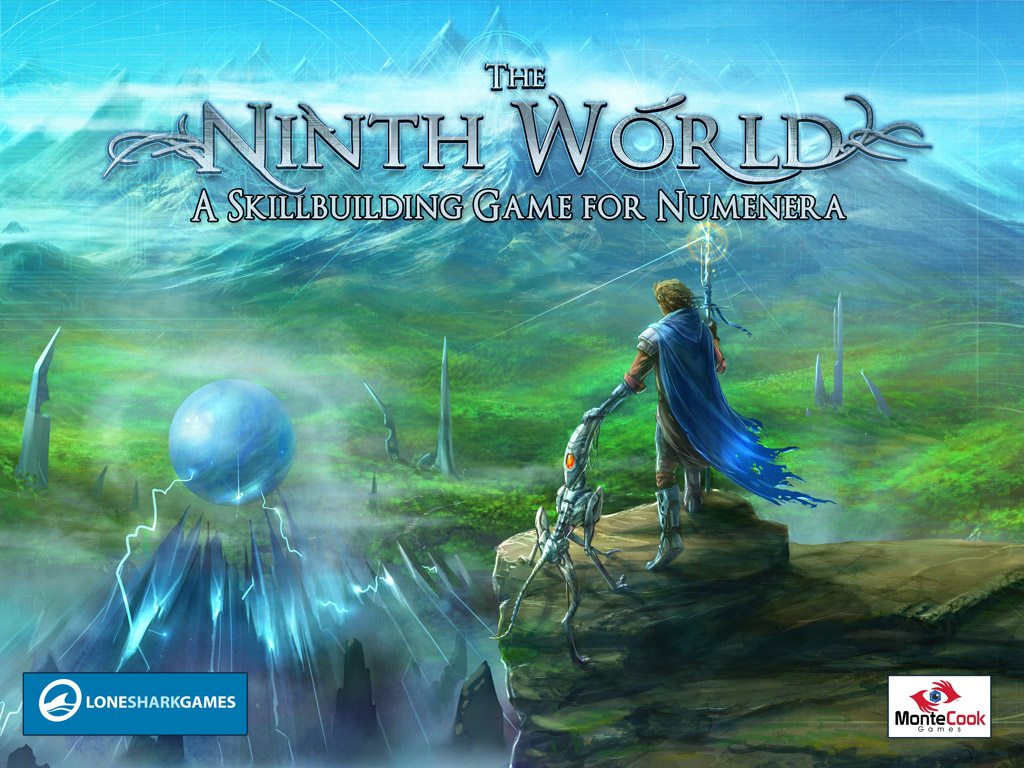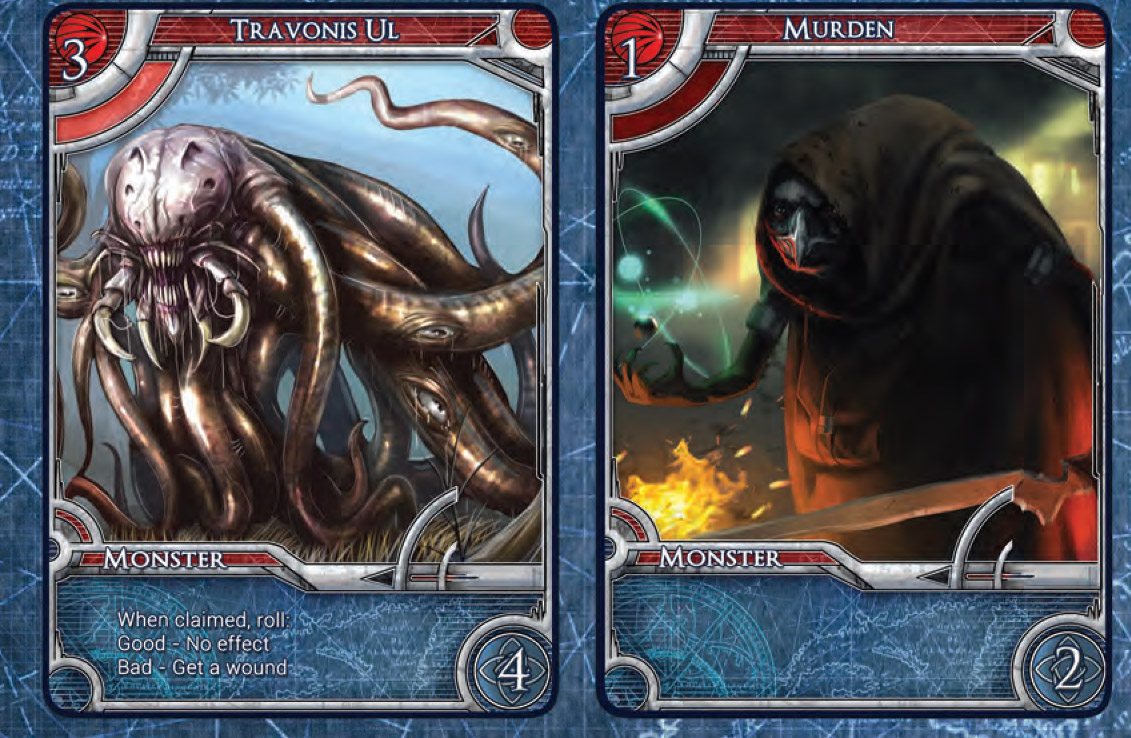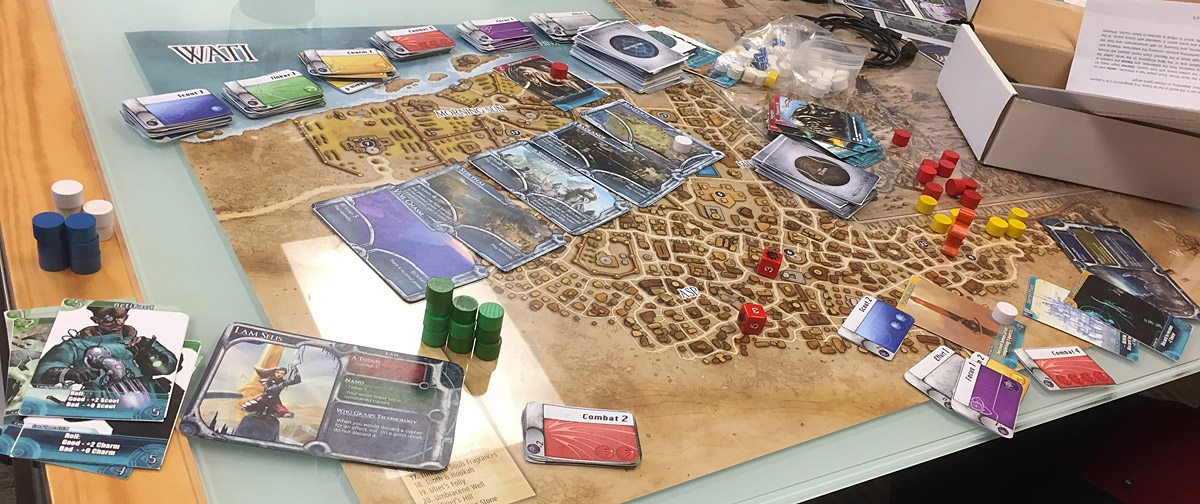 Lone Shark Games’ latest Kickstarter game, The Ninth World, is set in Monte Cook Games’ Numenera universe, and has some fresh, unique game mechanics that have labelled this a skillbuilding card game.
Lone Shark Games’ latest Kickstarter game, The Ninth World, is set in Monte Cook Games’ Numenera universe, and has some fresh, unique game mechanics that have labelled this a skillbuilding card game.
New to Kickstarter? Check out our crowdfunding primer. Please note that I played an early prototype copy of the game so final components and quality will be different from what you see here.
The game is designed by Paul Peterson, Boyan Radakovich, and Mike Selinker, with graphics by Shane Tyree and the artists of Numenera. I was lucky enough to get to sit down with Selinker at the Loan Shark Games office and play a prototype of the game. Spoiler alert: I won!
Game components
- 6 character tableaus (2 Nanos, 2 Glaives, 2 Jacks)
- 45 region cards (5 each in 9 kingdoms)
- 36 town cards
- 54 wilderness cards
- 115 skill cards
- 15 wound cards
- 5 bid cover cards
- a gamebook
- dice (special dice with four “good” sides and two “bad” sides)
- a turn marker
- 50 player markers
- scoring markers
- a monolith token
- unlocked preview cards–The Black Riage
You can currently grab a print and play demo version of the game as well.
Setup
 Game setup is very quick and easy. A region and its corresponding path cards are laid out, the skill cards are set to the side (like a bank), each player chooses their character and is given the associated starting skill cards (three effort cards and two different rank 1 skill cards based on their character), the monolith is given randomly to a player (this moves to the left at the end of each round and serves as a tie breaker), and town cards are dealt in a line to set up the initial town (number of town cards are equal to number of players plus one). I love a game that is this multi-layered but that can be set up very quickly.
Game setup is very quick and easy. A region and its corresponding path cards are laid out, the skill cards are set to the side (like a bank), each player chooses their character and is given the associated starting skill cards (three effort cards and two different rank 1 skill cards based on their character), the monolith is given randomly to a player (this moves to the left at the end of each round and serves as a tie breaker), and town cards are dealt in a line to set up the initial town (number of town cards are equal to number of players plus one). I love a game that is this multi-layered but that can be set up very quickly.
The region cards serve a couple of purposes. Not only does it depict the land you are adventuring in and through, but it also serves as the round tracker. Each round a marker moves across the region. Each card and round has a special modifier that slightly tweaks gameplay and should be taken into account when planning tactics. For a short game, only five rounds are played–using only the left side of the region cards. For a regular game, all nine round are played–you journey out and back across the region.
 I chose Selis–a tough nano who grasps technology–as my character, which started me with a combat, tinker, and 3 effort skill cards.
I chose Selis–a tough nano who grasps technology–as my character, which started me with a combat, tinker, and 3 effort skill cards.
Gameplay
Gameplay is divided into five phases:
- Scout – search the wilderness deck and mark what you find
- Tinker – find and recover ancient relics
- Charm – influence allies and pick-up quests
- Combat – defeat creatures
- Focus – advance your skills
Each phase is played the same at its core–each player uses their skill cards to secretly bid on how many skill points they are spending on that phase. Then all players reveal their bids and each player takes their turn in that phase in that order. There are six different types of skill cards–one corresponding to each phase and the effort cards, which can be thought of as entry-level wild cards. A card with the skill matching the phase produces the number of points matching its level; all other cards are only worth a single point. It is allowable for a player to bid nothing on any given round. Any points bid but not spent in a phase are immediately converted to victory points. The player with the most victory points at the end of the game wins.
Scout Phase
During the scout phase, you can reveal cards from the wilderness deck or mark cards previously revealed. Marking a previously revealed card costs one point, as does revealing and marking a new card. You can only attempt to claim a card that has one of your markers on it. Claiming cards happens in the phase that matches the card type (tinker, charm, or combat).
Tinker Phase
 During the tinker phase, you can spend points to claim artifacts but you can only attempt to claim artifacts from a single location–town or the wilderness. When a relic is successfully claimed, the victory points in the bottom right corner are immediately scored, and the relic is stored in front of you. Some relics, usually the more costly ones, have special abilities that can be used later in the game. For example, I had one relic that, each phase, would allow me to roll a die–on a good roll, I received +2 scout points, on a bad roll, I received none.
During the tinker phase, you can spend points to claim artifacts but you can only attempt to claim artifacts from a single location–town or the wilderness. When a relic is successfully claimed, the victory points in the bottom right corner are immediately scored, and the relic is stored in front of you. Some relics, usually the more costly ones, have special abilities that can be used later in the game. For example, I had one relic that, each phase, would allow me to roll a die–on a good roll, I received +2 scout points, on a bad roll, I received none.
Charm Phase
 The charm phase allows you to score yellow cards–allies or quests. Just like in the tinker phase, you can only claim charm cards from a single location. Allies usually help buff up your ability to bid at certain times. Quests sometimes give you immediate victory points, but more often require successfully completing some other objective, like successfully defeating a monster during the combat phase, to score additional victory points.
The charm phase allows you to score yellow cards–allies or quests. Just like in the tinker phase, you can only claim charm cards from a single location. Allies usually help buff up your ability to bid at certain times. Quests sometimes give you immediate victory points, but more often require successfully completing some other objective, like successfully defeating a monster during the combat phase, to score additional victory points.
Combat Phase
 The combat phase is also similar to both the tinker and charm phases in that you are using points to try to “claim” monsters, but claiming a monster is defeating it in battle. Higher point creatures present more risk and can actually do harm when defeating them (based on a die roll). If a wound card is received, it blocks your character’s special power. A wound can be removed by spending two points in the focus phase. Wound cards are also worth negative victory points at the end of the game, so it is to great advantage to not keep them around if you do get them.
The combat phase is also similar to both the tinker and charm phases in that you are using points to try to “claim” monsters, but claiming a monster is defeating it in battle. Higher point creatures present more risk and can actually do harm when defeating them (based on a die roll). If a wound card is received, it blocks your character’s special power. A wound can be removed by spending two points in the focus phase. Wound cards are also worth negative victory points at the end of the game, so it is to great advantage to not keep them around if you do get them.
Focus Phase
During the focus phase, you can upgrade any one skill by a single level. When a skill is upgraded, the new skill level replaces the existing card. A skill cannot be changed to a different skill with the exception of effort cards. When they are first upgraded, the player chooses which skill to convert it to. While it may be advantageous to a player to have multiple cards of a particular skill (to focus on combat for example), there is also an end of game bonus to having a rainbow of skills.
At the end of the round, all skill cards are placed back in a player’s hand, any town cards that were taken are replaced, the round marker moves to the next step on the region cards, and the monolith passes to the left.
At the end of the game, there are a couple of additional victory points that get scored before deciding the victor. Each player receives one point for each incomplete quest, one point for each marker on an incomplete quest, two points for skill ranking on skill cards (excluding effort cards), five points for having one of each skill card, five points for having one of each skill card at level two, and minus five points for each wound card.
Extras
Lone Shark Games has teamed up with DriveThru Cards to create a character card maker. This will not only allow fans of Numenera to bring their RPG characters to The Ninth World, but will give everyone an additional tool to expand the game and increase its replayability.
Stretch goals will include more regions, more characters, and more surprises!
 While the rules aren’t finalized for them yet, there will also be both solo and co-op play (because a Selinker game must have co-op). The beauty of the game, and what I’ve heard about these variations from Selinker, is that the majority of the gameplay and rules stay exactly the same with a slight tweak that essentially enables a player (solo) or players to play against the game itself in an almost tower defense fashion.
While the rules aren’t finalized for them yet, there will also be both solo and co-op play (because a Selinker game must have co-op). The beauty of the game, and what I’ve heard about these variations from Selinker, is that the majority of the gameplay and rules stay exactly the same with a slight tweak that essentially enables a player (solo) or players to play against the game itself in an almost tower defense fashion.
I’m pretty excited to get my hands on the final game and rules so I can not only share it with my friends, but try my luck in solo play as well.
There is a little over a week left on the campaign, so head over now to get your copy! Obviously, no Kickstarter campaign is a guarantee, but Lone Shark Games has produced tons of games and their campaigns are probably some of the least risky around.




